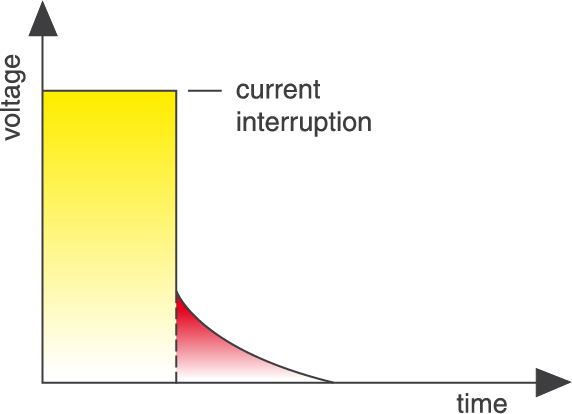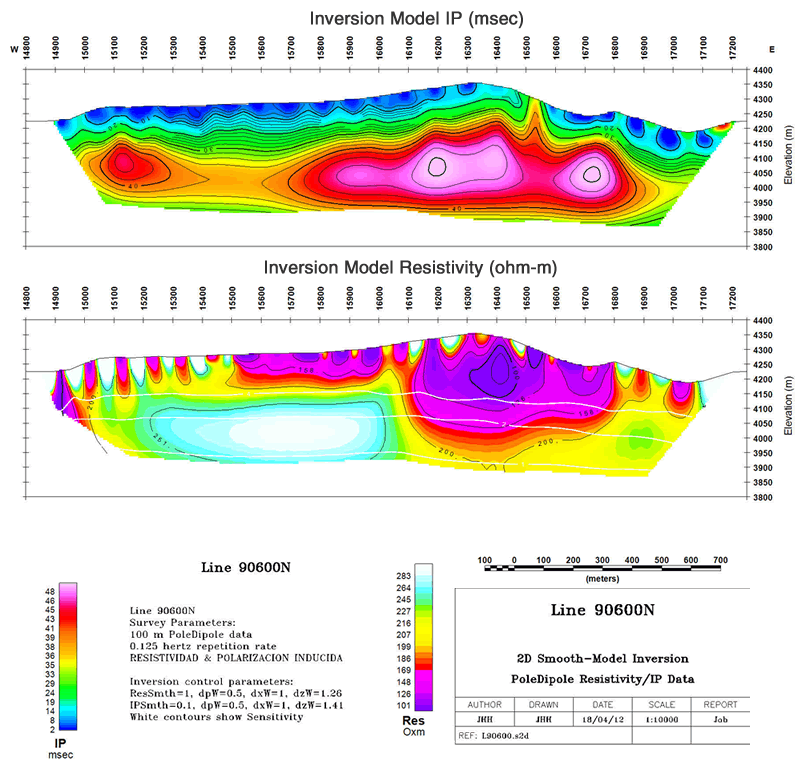INDUCED POLARIZATION
Induced polarization may be observed when electricity passes through an electrolyte containing electronic conductive particles (metals, semiconductives, and minerals.)
These systems charge the underground through the electricity electrolytes for a period of time, and receive the answer with a greater amount of time on the potential electrolytes. This way, it is analyzed how the underground is downloaded, specially the charge done for the metallic content of the soil.
With the flow of current it is possible to polarize conductive materials, therefore locating and representing the investigated bodies. Induced polarization consists in the measure of the decline of potential difference (V), after finishing the injection of intensity current (I). The device is formed by 2 current electrolytes (AB) and other 2 potential non polarized potentials (MN).
When current ceases to be applied through A and B, the potential difference between M and N lowers up to its disappearance (V=O) for a while, which normally varies among miliseconds.
These systems charge the underground through the electricity electrolytes for a period of time, and receive the answer with a greater amount of time on the potential electrolytes. This way, it is analyzed how the underground is downloaded, specially the charge done for the metallic content of the soil.
With the flow of current it is possible to polarize conductive materials, therefore locating and representing the investigated bodies. Induced polarization consists in the measure of the decline of potential difference (V), after finishing the injection of intensity current (I). The device is formed by 2 current electrolytes (AB) and other 2 potential non polarized potentials (MN).
When current ceases to be applied through A and B, the potential difference between M and N lowers up to its disappearance (V=O) for a while, which normally varies among miliseconds.


MAIN APPLICATIONS
- Mining exploration: Deposit detection based on its resistivity characteristic or PI
- Subterranean waters: Resistivity can detect subterranean odiferous
- Stratigraphic mapping: different kinds of soil and/or rocks can have different resistivity
- Geotechnical: soil and/or resistivity rock can be important in many geotechnical projects
- Environmental: IP methods may help in the evaluation of potential in rock sterile acid generation and mine operation tailing. Through resistivity pollution plumes can be mapped.
Geofísica Argentina © - 2015 - (All rights reserved)
Address: Bº UDAP II Mna F C17 - Rivadavia - San Juan - Argentina
Phone numbers:
+54 9 264 4854870 - +54 9 264 5883048 - +54 9 264 5318547
E-mail: info@geofisicaargentina.com
Address: Bº UDAP II Mna F C17 - Rivadavia - San Juan - Argentina
Phone numbers:
+54 9 264 4854870 - +54 9 264 5883048 - +54 9 264 5318547
E-mail: info@geofisicaargentina.com
Web design: Pica Estudio




